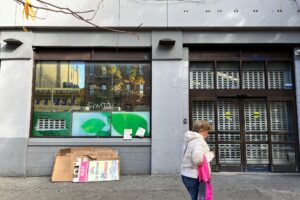First, Rite Aid declared bankruptcy, then CVS and Walgreens staff walked out. The turmoil has been dubbed “Pharmageddon.” Yet the South Bronx’s independent pharmacies persist, even gaining business since Mott Haven’s Rite Aid closed earlier this year.
“How long have we been here?” Norman Merker laughed as he turned around to consult an employee. “It has to be at least 20 years.”
Merker is the pharmacist and supervisor of Central Pharmacy & Surgical on 138th Street in Mott Haven, around two and a half blocks west of the closed Rite Aid. The store is much smaller, but stores like it have been filling the gap since Rite Aid’s closure.
Central Pharmacy’s 20 years pale in comparison to Kramer’s Pharmacy at Saint Ann’s and 141st: a sign outside advertises “Since 1925.” Owner Zannatul Firdoushi is only the third owner, following Joseph Kramer and Joseph Kramer, Jr.
“This is basically an icon in the neighborhood,” she said.
Newcomers, too, are adapting to the loss of Rite Aid.
“It’s unfortunate for the community,” said Edwin Tejada, who manages the Max Health Pharmacy on 137th Street, in the block south of the closed Rite Aid.
Max Health opened only two years ago. In many areas, a new independent pharmacy would be newsworthy in and of itself. But the South Bronx has dozens, and their business has been strengthened by Rite Aid’s closure.
“It brings way more traffic,” said Tejada.
He said he would estimate Max Health’s business increased between 30-40% when Rite Aid closed, mostly in prescriptions.
Still, Tejada said the closure is not necessarily a reason to celebrate. He notes that many of the issues Rite Aid found also cause problems for his business – such as shoplifting, inflation and supply chain issues. Also, he said, empty storefronts are never good for a neighborhood or its businesses.
At Central Pharmacy, Merker said he would have trouble estimating a percentage increase in business, since the change was slow over time. He agrees, though, that most of the business increase has come from prescriptions.
Similarly, Firdoushi said she sees prescriptions as the main driver of increased sales. The South Bronx has a higher than average rate of asthma and breathing-related issues, linked to high air pollution. Firdoushi said inhalers and other breathing-related medications are her top sellers.
“Every day, people get them,” she said, shaking her head.

With ongoing pharmacy closures, fears of pharmacy deserts are rising around the country, especially affecting Black and Latino urban residents. Still, the prevalence of independent pharmacies in the South Bronx has become an important resource.
While smaller stores cannot stock the same selection that a larger chain drugstore can, there are some benefits to being smaller. For example, Tejada said that based on requests, his pharmacy has added certain items, like a larger vitamin department. Unlike chain stores, he can customize the product selection to what his customers want.
“Those big stores, they don’t focus on the customers,” he said.
A few blocks north at Kramer’s, Firdoushi said running a pharmacy is a difficult business. Although she is an entrepreneur, owning two pharmacies in the Bronx, she said she and her staff encounter some of the same problems chain pharmacists cite in their walkouts.
“When you fill 500, 600 prescriptions a day, when you get home, you are done. Mentally and physically,” she said. She gestured to the prescription counter where three employees darted back and forth, grabbing medications from the shelving towering behind them and passing them across well-worn vinyl counters.
Still, she said, there is strength in numbers across the industry.
“Pharmacists need to unite,” she said.

